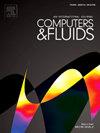Topology optimization for particle flow problems using Eulerian-Eulerian model with a finite difference method
IF 2.5
3区 工程技术
Q3 COMPUTER SCIENCE, INTERDISCIPLINARY APPLICATIONS
引用次数: 0
Abstract
Particle flow processing is widely employed across various industrial applications and technologies. Due to the complex interactions between particles and fluids, designing effective devices for particle flow processing is challenging. In this study, we propose a topology optimization method to design flow fields that effectively enhance the resistance encountered by particles. Particle flow is simulated using an Eulerian–Eulerian model based on a finite difference method. Automatic differentiation is implemented to compute sensitivities using a checkpointing algorithm. We formulate the optimization problem as maximizing the variation of drag force on particles while reducing fluid power dissipation. Initially, we validate the finite difference flow solver through numerical examples of particle flow problems and confirm that the corresponding topology optimization produces a result comparable to the benchmark problem. In the optimization cases, we explore both symmetric and asymmetric flow scenarios. For the symmetric flow case, the optimized flow fields indicate that serpentine flow fields can enhance particle drag variation while accounting for power dissipation. Furthermore, we investigate the effects of Reynolds numbers () and Stokes numbers () on the optimized flow field. The results demonstrate that increasing the Reynolds number results in more bends and greater curvature in the flow field, whereas increasing the Stokes number reduces these features. For the asymmetric flow case, gravity influences particle distribution, leading the serpentine flow paths to adjust their overall orientation to align with these regions of higher particle concentration.
求助全文
约1分钟内获得全文
求助全文
来源期刊

Computers & Fluids
物理-计算机:跨学科应用
CiteScore
5.30
自引率
7.10%
发文量
242
审稿时长
10.8 months
期刊介绍:
Computers & Fluids is multidisciplinary. The term ''fluid'' is interpreted in the broadest sense. Hydro- and aerodynamics, high-speed and physical gas dynamics, turbulence and flow stability, multiphase flow, rheology, tribology and fluid-structure interaction are all of interest, provided that computer technique plays a significant role in the associated studies or design methodology.
 求助内容:
求助内容: 应助结果提醒方式:
应助结果提醒方式:


